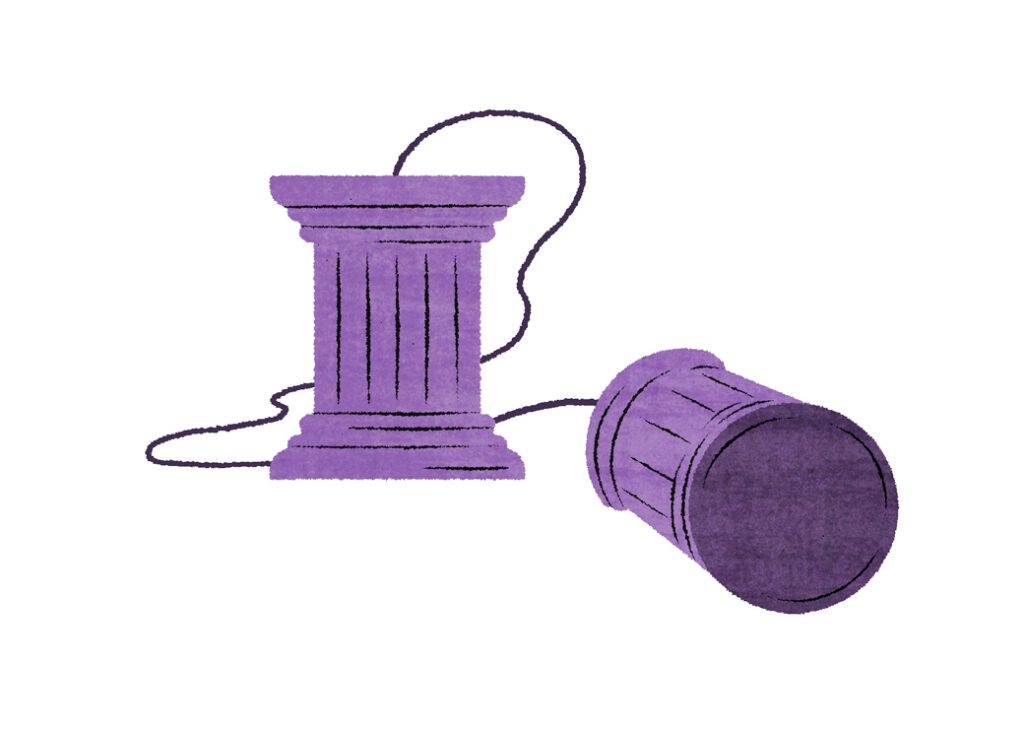
Is the messenger getting shot?
Middle management is an important intermediary between university staff and upper management. Can middle management bring the staff’s message to central management, or does it remain the messenger for upper management?
Text hannu kaskinen images Outi Kainiemi
English translation marko saajanaho
Paula Rossi, a postdoctoral researcher for Public Management at the University of Vaasa, summarises academic middle management as a message broker. They promote positive development by listening to their staff and taking the staff’s message to the decision-makers higher up the chain.
“Of course, middle management also take the upper management’s messaging to the staff. But hopefully, middle management look out for their own”, Rossi clarifies.
Rossi knows university staff generally have their own opinions as to how tasks should be handled. This puts middle management between a rock and a hard place.
Jari Stenvall, Professor of Administrative Science at the Tampere University has arrived at a similar but stronger conclusion. A year ago, he produced a report for the Finnish Union of University Professors, emphasising community and university democracy.
“University middle management seems to be increasingly considered upper management’s – i.e., the rectorate’s – stooges. The middle managers walk around with their backs all bent down”, Stenvall opines.
”University middle management seems to be increasingly considered upper management’s – i.e., the rectorate’s – stooges”
Jari Stenvall, Professor of Administrative Science at the Tampere University
Based on his experiences, he claims that middle management does not defend their subordinates or their unit as they used to. Less noise is coming from below than in the past. Some people in middle management are even afraid to voice critical opinions on strategy and leadership.
Change is only possible through dialogue
Rossi graduated as a Doctor of Administrative Science at the Tampere University in 2021. She believes democracy worked effectively at the old Tampere University. As a doctoral researcher, Rossi became very familiar with the administration, being a member of education development and doctoral education working groups and a backup member of the faculty council.
In February 2023, she was writing a research article on the Tampere university merger from a staff point of view.
“Leading an academic work community is not easy, especially during a merger process. Leadership is also made more challenging by the staff working as management, administration, and communications researchers, meaning substance experts.”
Rossi articulates that academic people are not happy to receive resistance to change. Decrees from the top are often criticised.
A critical mindset is baked into research work and the academic community. Having studied various conflicts, Rossi emphasises the importance of genuinely listening to the people affected by a change. Simple conversation that has no bearing on anything is false democracy.

“You don’t need to reach a consensus that pleases absolutely everyone. The managers hopefully know the issues that repeatedly obstruct research or teaching, so those are the ones to address. Sound criticism must not be swept under the rug as ‘resistance to change’.”
The Tampere University has received negative publicity recently, but Stenvall points out management issues are also occurring in other universities.
“Thankfully, we now have healthy dialogue about university leadership in Finland. I believe leadership will improve and middle management shapes up as well.”, Stenvall predicts.
The advantages of decentralised management
According to Stenvall, the universities are experiencing a faculty renaissance, i.e., dialogue regarding a decentralised management model. He reckons that stronger scientific units could improve inclusiveness. In decentralised management, middle management is responsible for all units and the rector assumes overall responsibility.
“For example, strengthening the relationship between middle management and the faculty council would promote democracy.”
One potential leadership direction according to Stenvall is one that respects polyphony, or many different voices. It requires interaction, and upper management must provide the experience of participation and being heard.
“We also need vision. In most cases, I doubt middle management puts enough thought into what their unit might look like in five years and how to enact positive change.”
Stenvall offers the idea that each faculty could pick their own leadership model, with different units operating under different management styles. This can be justified by the differences between fields alone. It goes without saying that responsibility is also required alongside decentralisation.
He emphasises that university management must happen close to the actual activity, meaning research and teaching.
“The crossroads between research and teaching are the points of success and breakthroughs. This is something university rectors and boards have not recognised nearly enough. That is why university leadership is old-fashioned compared to many businesses and even public organisations.”
In Stenvall’s ideal university environment, middle management trusts their staff – universities are communities of high competence, after all. He finds it strange how the rest of society sometimes seems to trust university workers more than their university’s own leadership does.
Rossi would increase the decision-making power of the faculty council, especially if the council was to convey the voice of the staff to the university’s management more effectively.
“University democracy dictates that the staff should be represented when strategies and policies are created.”
“University democracy dictates that the staff should be represented when strategies and policies are created.”.
Paula Rossi, postdoctoral researcher for Public Management at the University of Vaasa,
The risks of decentralised management
Alongside the need for structural change, Stenvall emphasises leadership competence. As the head of their unit, a professor might view matters through the narrow lens of their own field, rather than looking at the whole. Fortunately, leadership competence is something that can be developed.
“It is not easy to move from centralised management to decentralised. When doing change studies, I saw that bowing down to senior management makes it harder to gain the trust of the community”, Stenvall points out.
He notes that the risks of decentralised management must be recognised. University democracy may take a step back simply because of a dean making arbitrary decisions.
Whether a dean is part of senior or middle management is largely down to interpretation. Middle management is always subject to expectations from both senior management and their subordinates.
If middle management is expected to improve at academic leadership, Stenvall also expects stronger academic competence from them.
“Middle management may be responsible for university staff evaluation according to criteria in salary and development conversations. I have also seen that when your superior is not an academic, it’s difficult to improve salaries based on academic achievements”, Stenvall specifies.
Studying the middle management of municipalities, Stenvall discovered that reducing middle management revealed learned helplessness in terms of leadership.
“When change was happening, they could not assume the responsibility allowed by the changed models. Middle management was used to taking orders from higher up. This presents a genuine risk for the universities as well if their management is decentralised.”
Close and people-centred
For roughly twenty years, Stenvall has been talking about people-centred management. Now, he sees people being emphasised more and more in skilled management.
“People-centred management means taking responsibility, creating the conditions for people’s wellbeing. The competence of middle management can be seen from whether people are succeeding in their daily life and whether they see their work as meaningful.”
University management positions are held in high esteem. However, Stenvall emphasises that the leader must understand they are there to ensure the rest of the staff are able to do their jobs effectively. Poor leadership can even endanger staff wellbeing and health.
Stenvall assumes too many university leaders are in management positions for the status. Such leaders are often power-focused and uncertain.
“Working in management can also change your personality. I’ve seen people in the university management career path lose their sense of empathy and human focus over time.”
As Stenvall puts it, results are born from people’s actions and leadership means solving problems.
“If students aren’t graduating, research isn’t being done, and students are complaining about poor treatment, management has to step in.”
It is essential to focus on solutions. Needless instructions are needless. A leader must lead when leadership is required.
Rossi wishes for immediate superiors to be accessible. That would send the message that the staff is appreciated, which in turn would improve the staff’s trust in middle management.
In Rossi’s opinion, the contact between middle management and the staff is an important part of middle management’s job description. This contact is largely dependent on middle management’s working methods.
“We certainly don’t need new communications channels or feedback surveys. What we need is something personal. And the better middle management knows the staff, the better their chances to succeed as a message broker. Withdrawing is not good for anyone.”
Rossi stresses that all managers must have people management skills while being open and present.
When middle management’s list of tasks became too long

“Middle management tasks must be clearly defined and fairly compensated. The percentage equivalent of administrative work must be separated from standard work.”
This summary of a Head of Unit’s tasks comes from a Tampere University professor who worked in their university’s faculty administration from 2017 to 2021, meaning before and after the university merger.
“At the old Tampere University, the list of tasks for administrative work was quite well defined, and the separate compensation of a few hundred euros was appropriate for the task.”
The people in charge of each discipline expressed their opinions in intra-unit meetings. The Head of Unit collected these points to determine the strengths and development needs, presented them to the faculty leadership and then to senior management. The messages went from the staff to the administration and vice versa. The job description was clear.
The university merger reduced communication to unilateral, top-down.
“Most of the meeting time was spent on them telling us about changes and giving us tasks or messages to be relayed to the unit. There was very little time to address the goings-on in the units even though the meetings became longer.”
The Head of Unit thinks these practices are likely unavoidable at the start of a merger, but over time the model becomes taxing and reduces staff members’ opportunities to influence matters.
More work, less influence
Major upheavals in different areas meant a large increase in the workload for the Heads of Units. As support personnel were laid off, their jobs replaced by electronic systems, those jobs fell on teaching and research staff.
In this Head of Unit’s faculty, the heads were able to negotiate administration work to comprise fifth of their working hours, but according to the professor we interviewed, that work took up at least half of their normal working hours.
The Heads of Units relayed messages about staff facility requests and requirements and support personnel shortages upwards through many channels. The messages achieved no results.
The Head of Unit had to do more work than before, yet they had less influence on decisions.
“The sound staff plan devised by us and approved by the unit had to be approved by the faculty first, then the provost who determines all the current employment contracts for the entire university. Even then, recruitments outside the plan aren’t always discussed with the Heads of Units despite the fact they affect those Heads of Units’ work.”
The pace also increased. The central administration might send a message stating that one matter or another had to be addressed on a day or two’s notice, or at least before the next meeting.
“Responsibilities and influence must both be documented”
The Heads of Units were handed numerous responsibilities but no influence on decisions. For instance, they are responsible for ensuring the unit complies with privacy policy guidelines. However, it is difficult to find ways to monitor this in a large unit.
The Head of Unit felt responsible for the decisions made by central administration, despite not agreeing with all of them. They felt many of the changes hurt both the basic operations of their unit and the university’s profits.
After five years, the Head of Unit left their position.
“I realised I didn’t have enough time. As a professor, I have always been in charge of many research projects, including some big ones. In addition, I advise master’s thesis groups and teach courses.”
The former Head of Unit proposes that the Heads of Units’ tasks should be clearly defined and documented at the beginning of their term. There must be a balance between influence and responsibilities.
“In addition, a percentage equivalent of administrative work should be determined and separate from other work. Appointing a secretary for the Head in a larger unit, or a general secretary for smaller units, would be helpful.

